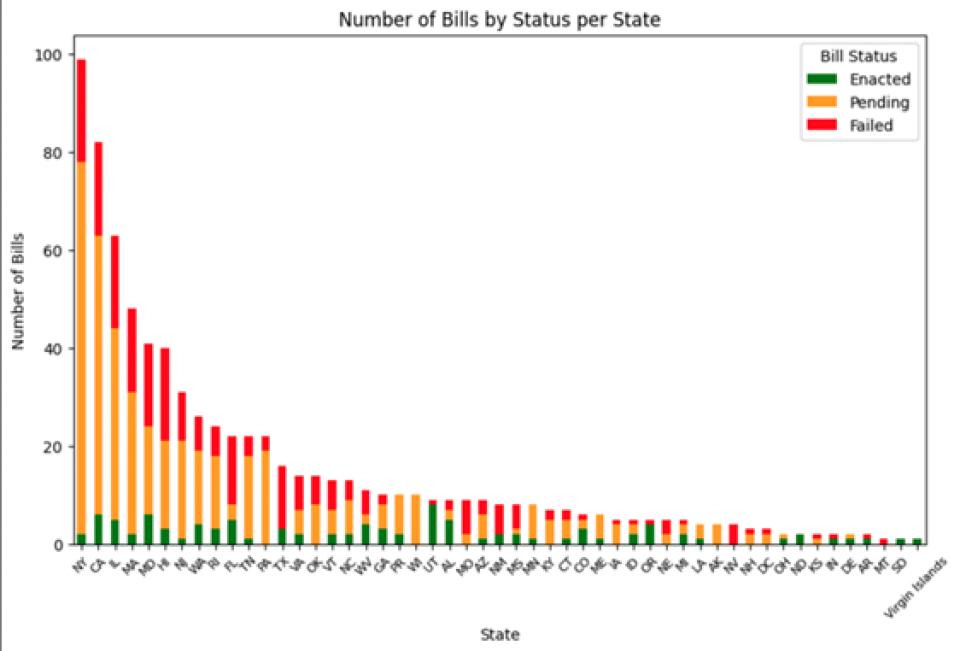The State of Artificial Intelligence Regulation in the U.S.
Distinguished Professor Hemant Bhargava and UC Davis undergraduates advocate for greater AI regulation

Artificial intelligence has taken the world by storm.
Unlike previous emergent technologies such as social media or search, there is rapid recognition of the urgent need for regulating AI tech in the public and private sector.
In the U.S., legislative action has predominantly occurred at the state-level because the federal government has yet to move from general frameworks and recommendations to enacting federal laws about artificial intelligence.
Many users understand the potential harms of AI such as bias, fraud, security and privacy, leaving questions such as:
- What are state governments doing to solve this?
- What are their efforts and accomplishments?
- Who is taking the lead? Who's following?
- What are the focal points of legislation?
A few answers are emerging, based on a database of state-level AI bills (enacted, failed and pending) which we drew from the National Council of State Legislatures (NCSL) covering the past five years. Analysis of these bills paints a national legislative landscape around artificial intelligence.
What is the Current State of AI Legislation?
Using the NCSL’s categorization scheme, we found that policy-making predominantly revolves around the government’s use of AI.
Government use of AI accounts for 20% of legislation introduced, closely followed by bills related to private sector use of AI (17%). The focus of government on rules around its use of AI is potentially motivated by fears and concerns such as violation of data privacy, data security, algorithmic bias, etc. This appears to be consistent with lack of speedy diffusion of AI in internal and outward-facing activities.
Interestingly, some important categories, such as child pornography, criminal use and cybersecurity, only became the focus of legislation this year in 2024. Similarly, "responsible" use of AI has become a more prominent focus in 2023-2024.
Two vital categories, social and media, each account for only about 10 percent of proposed legislation despite dominating societal chatter about AI concerns on topics such as algorithmic discrimination and responsible deployment of AI.
Importantly, provenance accounts for roughly 1% of proposed legislation. This concerns the requirement of disclosures regarding the data used to train AI systems on, which is incredibly important for validating the efficacy and lack of bias in AI models.

Who’s Leading AI Policy-making?
We expected California to top the list given its technological leadership driven by Silicon Valley.
However, New York surpassed California in proposing AI legislation! And then, again, California has been more successful at enacting legislation (as did Oregon, Utah, Maryland, Illinois, and Florida).
Next Steps
Besides the basic question of "Which states are leading the charge in AI regulation?", several additional questions emerge which form our roadmap for further research:
- Is there a ‘copycat’ effect in the legislation that is produced, are some states (possibly the less active ones) piggybacking on the work of other more active states in forming their own AI regulation?
- If so, what are the pro and con implications of such copycat behavior?
- What factors are driving the dominance of "government's own use of AI" in AI-related policy-making?
- What are some trends that exist with respect to state-based regulation?
- Are there any political correlations?
- Correlations with characteristics of industry ecosystem and private enterprise within the states?
- For instance, do states with heavy concentration of finance and banking take a different tack vs states that are dominated by healthcare or by manufacturing?
These are questions that we aim to tackle in our next iteration of the project. Stay tuned.
We're grateful to Professor Jan Krämer, and to Tom Negrete from the California Research Bureau and Daniel Harris-McCoy from Little Hoover Commission for discussion of these issues.


